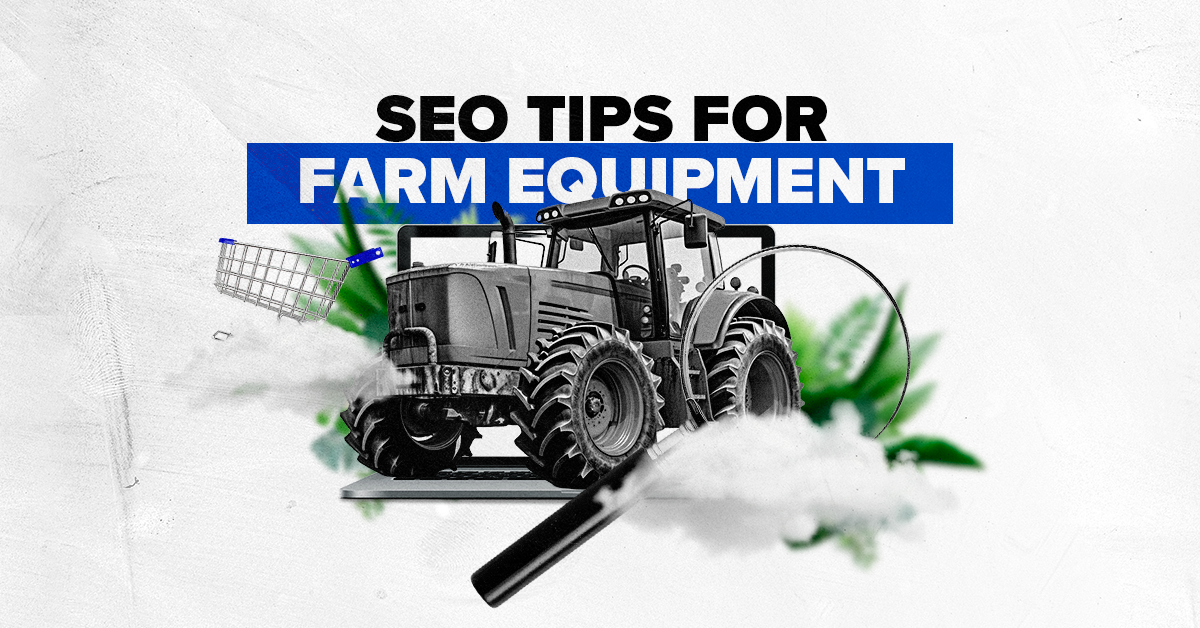
Farm equipment dealers face brutal competition online. Farmers search for tractors, combines, and harvesters with intent to buy, but most dealerships lose those prospects before they even load your website.
The difference between showing up on page three versus owning the top spot when someone searches "used John Deere tractors near me" comes down to a methodical SEO strategy. Not luck. Not magic.
I've watched ecommerce businesses transform their visibility by following systematic optimization processes. The same principles that work for automotive parts and heavy equipment apply directly to farm machinery dealerships. You need clean technical infrastructure, location-specific optimization, and inventory pages that Google can actually understand.
This checklist covers every element that moves the needle for equipment dealers. From the code running your website to the way you describe a 2018 Case IH combine, each component builds on the last. You'll learn how to structure your site so search engines reward you with traffic, not penalties.
By the end, you'll have a clear roadmap to outrank competitors and capture farmers actively looking for equipment. No fluff, just the specific actions that drive results.
Your website's code quality dictates whether search engines can crawl and index your inventory. Clean HTML and CSS create the foundation everything else builds upon.
SEO-optimized website structures for farm equipment dealers should feature SEO-friendly code, fast loading speeds, and responsive design. These three elements separate sites that rank from those buried on page five.
Google measures how fast your pages load. Every second of delay costs you visitors and rankings.
Websites with clean HTML/CSS and optimized images load faster, reducing bounce rates. When a farmer searches for equipment during lunch break, they won't wait for bloated pages to render.
Compress your tractor photos before uploading them. A 5MB image of a combine takes forever to load on rural internet connections. Get those files under 200KB without sacrificing quality.
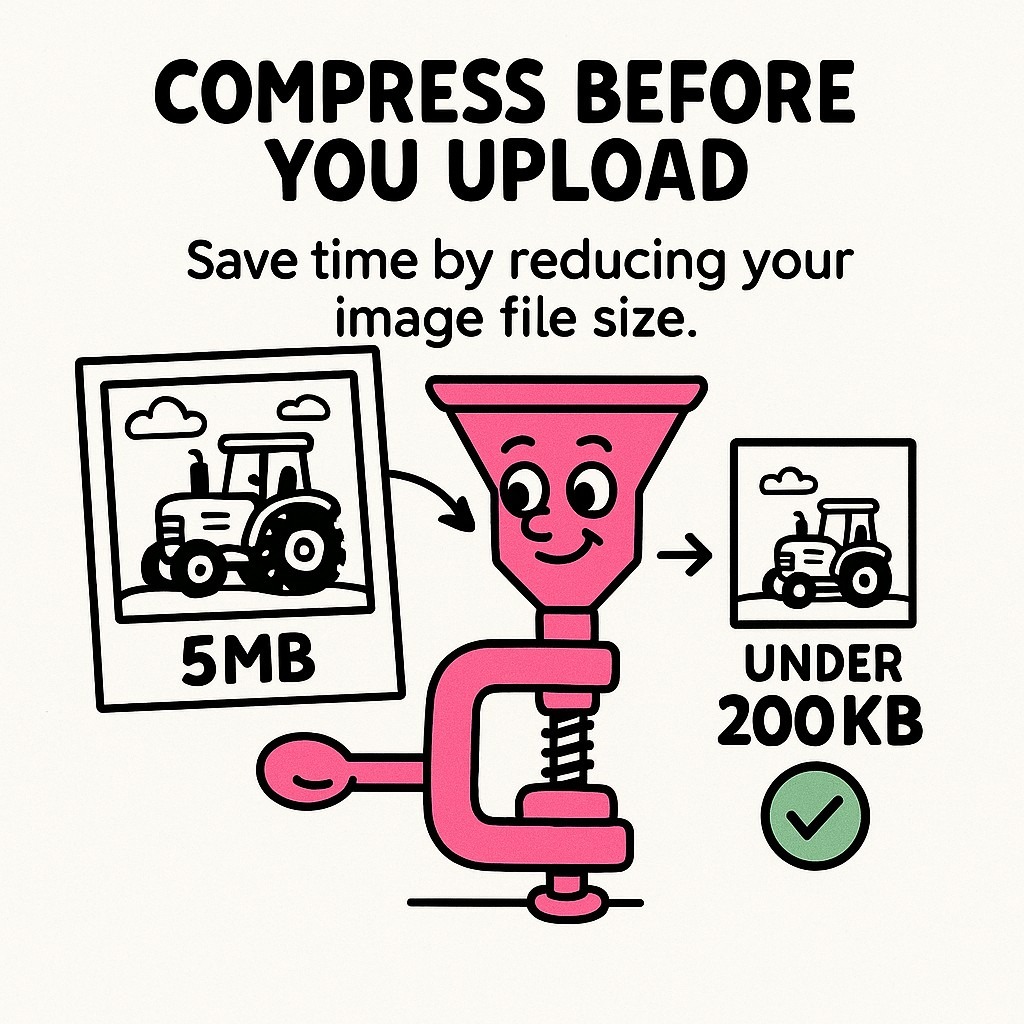
Compress tractor and combine photos under 200KB before uploading to keep inventory pages fast.
Enable browser caching so returning visitors load pages instantly. Minify your CSS and JavaScript files to shave milliseconds off load times.
Farmers check inventory from their phones while working fields. Your site needs to function perfectly on small screens.
A fully responsive and mobile-friendly website is critical for both user experience and SEO rankings. Google prioritizes mobile versions of websites in their index.
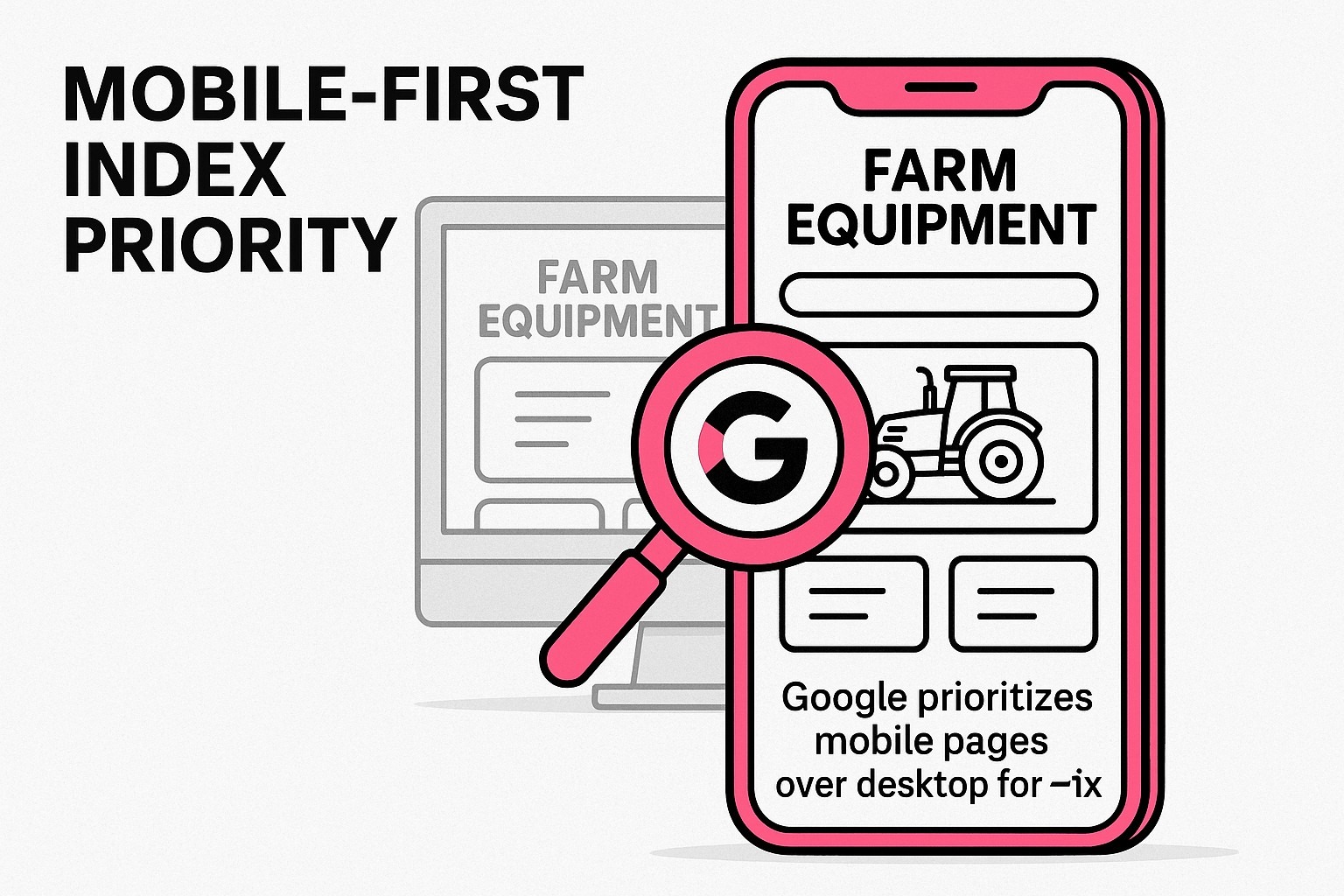
Google’s mobile-first index makes responsive, fast mobile UX a critical ranking factor.
Test your equipment pages on actual phones, not just desktop browsers. Buttons need to be large enough for fingers wearing work gloves. Text must stay readable without zooming.

Test inventory pages on real phones—ensure buttons work for gloved hands and text stays readable.
Navigation should work smoothly with thumbs, not just mouse cursors. If someone can't easily browse your used tractor inventory on their iPhone, you've already lost them.
Farm equipment sales happen locally. A dealer in Iowa doesn't ship tractors to Texas. Your SEO strategy needs geographic precision.
Now that your technical foundation works properly, focus on dominating local search results where your actual customers live and work.
Dealers must claim and optimize their Google Business Profile to improve visibility in local search. This free tool puts your dealership on Google Maps and local pack results.
Fill out every field in your profile completely. Add photos of your lot, showroom, and staff. Upload images of actual inventory, not stock photos.
Choose the right business category. "Farm Equipment Dealer" beats generic "Agricultural Service" for local searches. Add secondary categories for specific equipment types you specialize in.
Collect and respond to reviews consistently. When farmers search "tractor dealer near me," Google shows businesses with recent positive reviews higher in results.
Create dedicated pages for each area you serve. If you deliver equipment to three counties, build three location-specific pages.
Each page should mention specific towns, landmarks, and regional farming operations. Talk about soil conditions, crop types, and seasonal needs relevant to that area.
Include the county name in page titles and headings naturally. "Serving Montgomery County Farmers Since 1987" works better than "About Our Service Area."
Offering multilingual website options can expand reach and improve local SEO if you serve communities with Spanish-speaking farmers or other language groups.
Understanding how farmers search helps you optimize pages for the right terms. Generic keywords won't cut it in this specialized market.
With your local foundation established, identify the specific search phrases that indicate buying intent from agricultural customers.
Farmers search with precision. They don't type "tractor" - they search "John Deere 7230R used" or "Case IH Magnum 340 for sale."
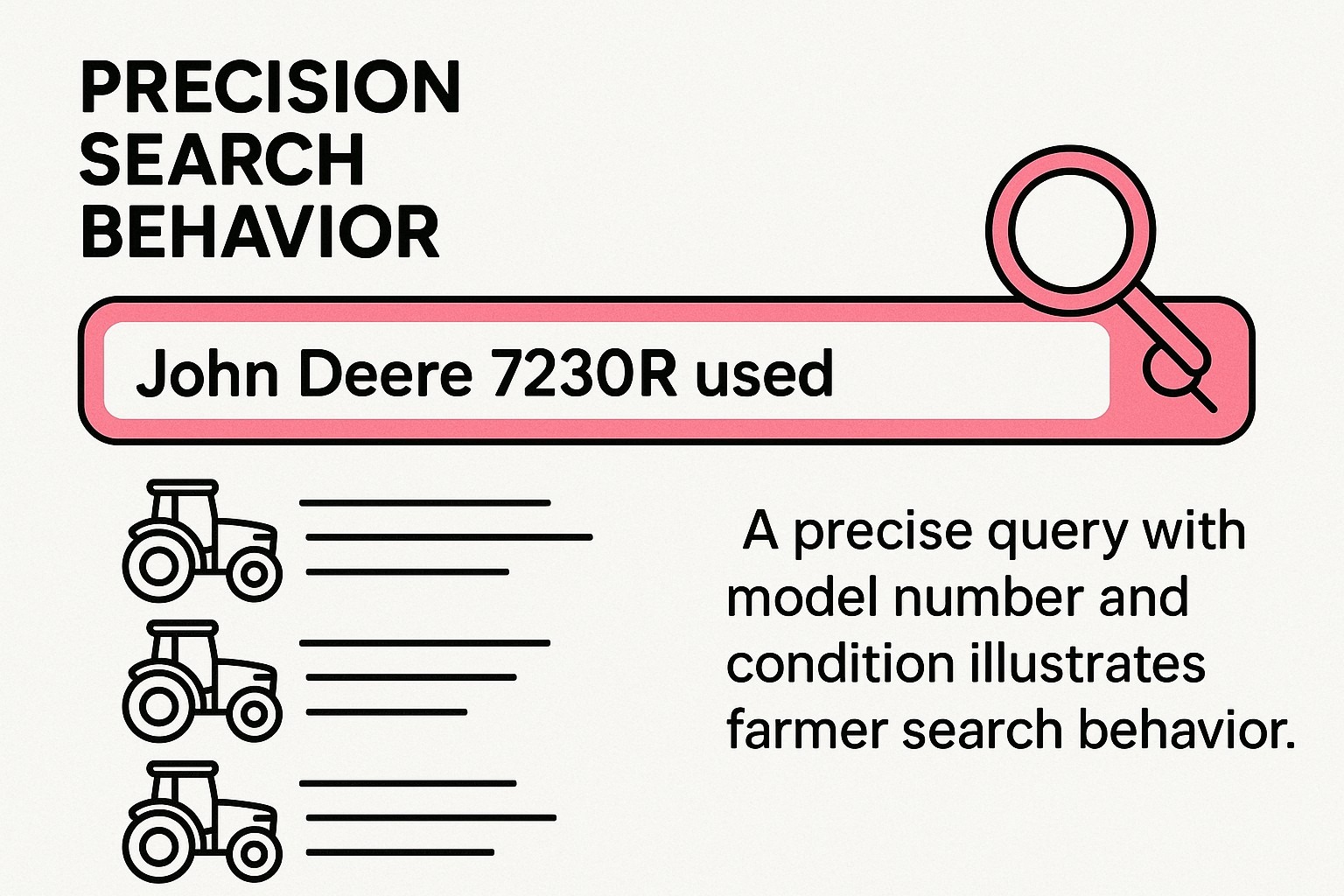
Farmers search with precise model terms like "John Deere 7230R used" and "Case IH Magnum 340 for sale."
Build keyword lists around manufacturer names, model numbers, and equipment categories. Include horsepower ranges, year ranges, and condition modifiers like "used" or "certified pre-owned."
Track seasonal patterns too. "Combine harvester" searches spike in late summer. "Planting equipment" peaks in early spring. Time your inventory promotions and content around these cycles.
Combine equipment terms with location modifiers. "Used tractors Iowa" or "John Deere dealer Des Moines" capture farmers searching in your service area.
Use Google Search Console to find which terms already drive traffic to your site. Double down on those winners by creating dedicated landing pages.
Don't ignore long-tail phrases. "Affordable used compact tractor for small farm" might get less search volume, but those searchers often convert better than generic queries.
Each piece of machinery in your inventory deserves its own optimized page. Treating equipment like products transforms your website into a search-friendly catalog.
After identifying your target keywords, structure individual equipment pages to rank for those specific terms while serving customer information needs.
Your page title appears in search results as the blue clickable link. Make it count.
Format: "Year Make Model - Condition - Price/Location - Dealer Name"
Example: "2020 John Deere 6155R - Used - $89,500 - Johnson Farm Equipment"
Keep titles under 60 characters so Google doesn't cut them off. Include your target keyword near the beginning.
Meta descriptions don't directly impact rankings, but they affect click-through rates. Write compelling 155-character descriptions that highlight key specs and availability.
Use H1 tags for equipment names. Only one H1 per page - make it the model designation.
Structure content with H2 subheadings for specifications, features, pricing, and availability. This helps search engines understand page structure and improves scannability for visitors.
Include detailed specifications in organized sections. List horsepower, weight, dimensions, engine details, and transmission type. The more complete information you provide, the better your pages perform in search.
Write unique descriptions for every piece of equipment. Duplicate content hurts rankings. Even similar tractors need distinct descriptions highlighting what makes each unit special.
Photos sell equipment, but they also impact SEO when optimized correctly.
Name image files descriptively before uploading. "2019-kubota-m7060-left-side.jpg" beats "IMG_4829.jpg" for search visibility.
Add alt text to every image describing what it shows. "Front view of 2019 Kubota M7060 tractor with loader attachment" helps search engines understand your photos.
Compress images to load quickly without losing quality. Use tools to reduce file sizes before uploading them to your website.
Some dealers now sell equipment directly through their websites. This requires specific technical setup to function properly.
Building on your optimized equipment pages, adding transaction capabilities opens new sales channels while requiring additional SEO considerations.
Integrating e-commerce functionality, such as WooCommerce, allows for direct online sales and inventory display. This WordPress plugin handles product catalogs, pricing, and checkout processes.
Configure product categories for different equipment types. Tractors, combines, implements, and attachments each need separate category pages.
Implementing advanced filtering and search options helps users find specific machinery, improving engagement. Let customers filter by brand, horsepower range, price, and year.
Not every piece of equipment sells directly online. High-value machinery needs personal consultations.
Easy-to-use forms enable buyers to request information or quotes, generating leads. Place these forms prominently on every equipment page.
Keep forms short. Name, email, phone number, and message field - that's it. Every additional field reduces conversion rates.
Respond to form submissions within an hour. Farmers comparing multiple dealers choose whoever answers first.
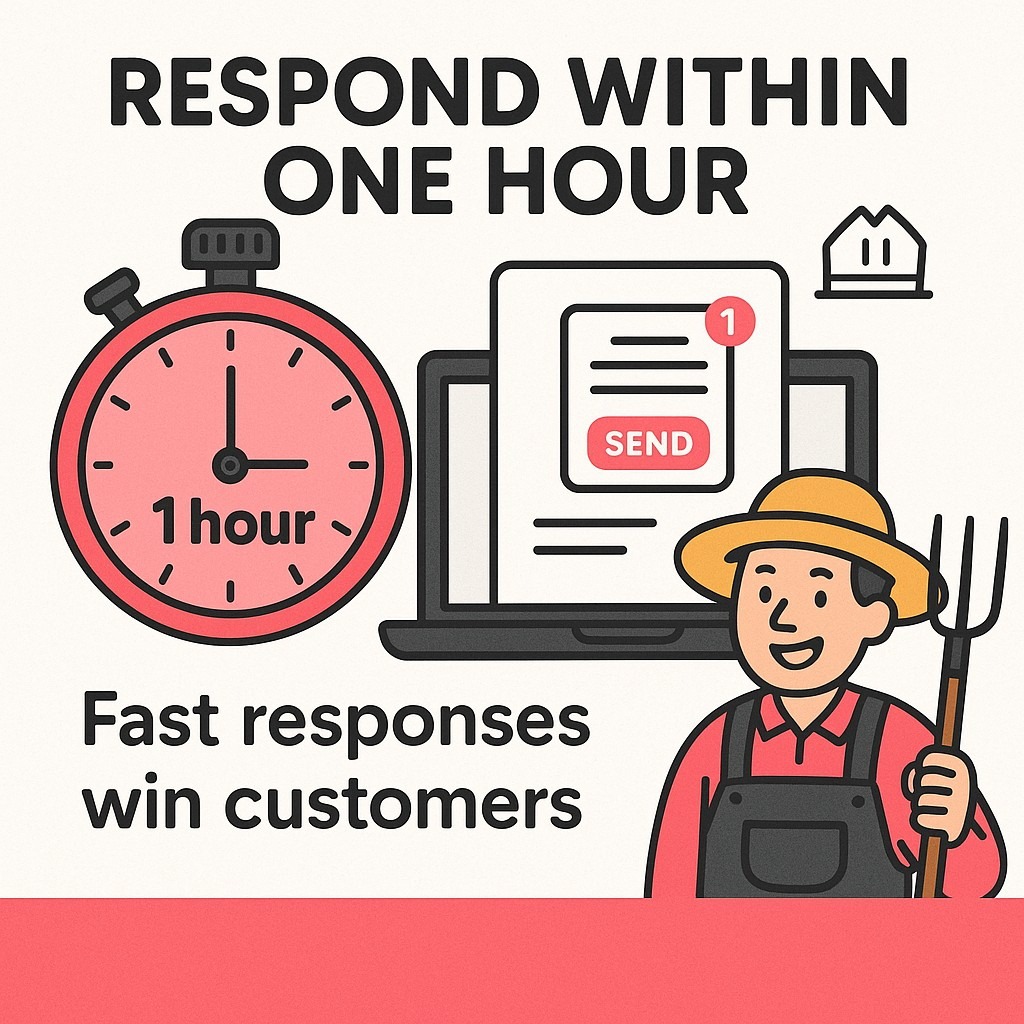
Reply to quote requests within one hour to win the lead against competing dealers.
Publishing helpful content brings organic traffic from farmers researching equipment decisions. This builds authority and captures early-stage buyers.
With your product pages optimized, create supporting content that answers questions farmers ask before making purchase decisions.
Blogging about farm practices, equipment maintenance tips, and industry news can help attract targeted traffic. Write about topics your customers actually care about.
Cover equipment comparison guides. "John Deere vs Case IH Tractors: Which Brand Fits Your Operation?" attracts farmers researching major purchases.
Publish maintenance schedules for popular models. "7 Maintenance Tasks for Your Kubota M-Series Tractor" provides value while establishing expertise.
Share seasonal preparation guides. "Getting Your Planter Ready for Spring" draws traffic when farmers plan upcoming seasons.
You can learn more about creating engaging content for specialized industries through systematic approaches.
Walk-around videos of inventory pieces perform exceptionally well. Farmers want to see equipment from every angle before visiting your lot.
Create short videos highlighting key features of each major piece. Point out condition details, demonstrate controls, and show equipment running.
Upload videos to YouTube and embed them on product pages. This provides SEO value on both platforms while giving customers what they need to make decisions.
Include transcripts or detailed descriptions with videos. This text helps search engines understand video content and improves accessibility.
Schema markup tells search engines exactly what information appears on your pages. This enables rich snippets in search results.
After creating solid content, add structured data to help Google display your information more prominently in search results.
Schema markup for products, reviews, and business information can enhance search listings with rich snippets. These enhanced results include images, pricing, and availability directly in search.
Implement Product schema on every equipment page. Include fields for name, description, image, brand, model, offers (price), availability, and condition.
Add AggregateRating schema if you have customer reviews. Star ratings in search results dramatically improve click-through rates.
Your homepage and location pages need LocalBusiness schema. This tells search engines your dealer name, address, phone number, hours, and geographic service area.
Include complete contact information in schema markup. Match this information exactly with your Google Business Profile to avoid confusion.
Add opening hours schema so Google can show when you're open directly in search results. This reduces friction for potential customers.
Links from other websites signal authority to search engines. Quality links improve your rankings more than almost any other factor.
With all on-page elements optimized, focus on earning links that demonstrate credibility to both search engines and potential customers.
List your dealership in agriculture-specific directories. Farm equipment associations, regional agricultural organizations, and manufacturer dealer locators all provide valuable links.
Submit to equipment auction sites even if you don't sell through them. Many aggregate dealer information and provide quality backlinks.
Join local business associations and chambers of commerce. These organizations typically list members on their websites with links back to your site.
If you're an authorized John Deere, Case IH, or Kubota dealer, get listed on their official dealer locator pages. These high-authority links significantly boost your credibility.
Participate in manufacturer co-op advertising programs. Many include online components that generate backlinks to your website.
Sponsor local agricultural events and 4-H programs. Event websites often list sponsors with links, and this builds community goodwill simultaneously.
Learn more about strategic linking approaches for dealership websites that improve navigation and SEO performance.
Farmers need confidence before making six-figure equipment purchases. Your website must establish credibility immediately.
After attracting traffic through strong SEO, convert those visitors with trust-building elements that demonstrate reliability.
Displaying customer testimonials and integrating social media build trust and encourage inquiries. Real feedback from actual farmers carries enormous weight.
Request reviews from satisfied customers after successful transactions. Email them two weeks after delivery asking for feedback.
Display reviews prominently on your homepage and equipment pages. Include customer names, farm names, and photos when possible for authenticity.
Respond to all reviews, both positive and negative. This shows you value customer feedback and care about service quality.
Show manufacturer certifications and authorized dealer badges. These instantly communicate legitimacy to visitors unfamiliar with your dealership.
Display years in business prominently. "Serving Farmers Since 1972" immediately establishes credibility.
Include photos of your actual team, facility, and service department. Generic stock photos reduce trust, while real images build connection.
Several technical factors affect rankings but often get overlooked by equipment dealers focused on inventory.
With visible elements optimized, address backend technical issues that search engines evaluate when determining rankings.
Create an XML sitemap listing all equipment pages, blog posts, and location pages. Submit this to Google Search Console so search engines discover your content efficiently.
Set up Google Search Console and verify your property. This free tool shows which keywords drive traffic and identifies technical issues affecting performance.
Monitor Search Console weekly. Check for crawl errors, mobile usability issues, and indexing problems that might hurt rankings.
Utilizing footer areas for extra content and strong internal linking aids navigation. Your footer provides SEO value when used strategically.
Link to key category pages from your footer. This ensures search engines can access your main equipment categories from every page.
Create internal links between related equipment pages. Link similar tractors, comparable implements, and complementary attachments naturally within descriptions.
Build contextual links from blog posts to relevant equipment pages. An article about tillage practices should link to plow and disk listings.
Understanding different traffic sources and their role helps you balance SEO with other marketing channels effectively.

Tracking results shows what's working and what needs improvement. Data-driven optimization beats guesswork every time.
After implementing all previous checklist items, establish measurement systems to quantify results and guide ongoing improvements.
Track organic traffic growth month over month. Use Google Analytics to separate organic search traffic from other sources.
Monitor keyword rankings for your target terms. Track positions for equipment-specific and location-based keywords weekly.
Measure conversion rates from organic traffic. Calculate how many visitors from search become leads or purchases compared to other traffic sources.
Watch average session duration and pages per session. Engaged visitors exploring multiple equipment pages signal quality traffic.
Review Search Console data monthly. Identify pages with high impressions but low click-through rates - these need better titles and descriptions.
Update equipment pages when inventory changes. Remove sold items promptly and add new arrivals with complete optimization.
Refresh blog content annually. Update statistics, add new information, and improve older posts to maintain their rankings.
Test different approaches and measure results. Try varied title formats, description styles, and content structures to find what works best for your specific audience.
Check out how planning differs from execution when implementing long-term SEO strategies.
What is a SEO to-do list?
A structured checklist of tasks to optimize a website for search engines, covering keyword research, on-page elements like titles and meta descriptions, content quality, internal linking, technical SEO factors like speed and mobile-friendliness, and regular updates to maintain rankings and user experience.
How long before SEO changes show results?
Technical fixes often show improvement within 2-4 weeks. Content and link building typically take 3-6 months for significant ranking changes. Competitive keywords in equipment sales may require 6-12 months of consistent effort.
Should I hire an agency or handle SEO myself?
Start with the technical foundation and on-page optimization yourself using this checklist. Consider outside help for advanced link building, technical audits, or if you lack time to execute consistently. Many dealers handle basics internally while outsourcing specialized tasks.